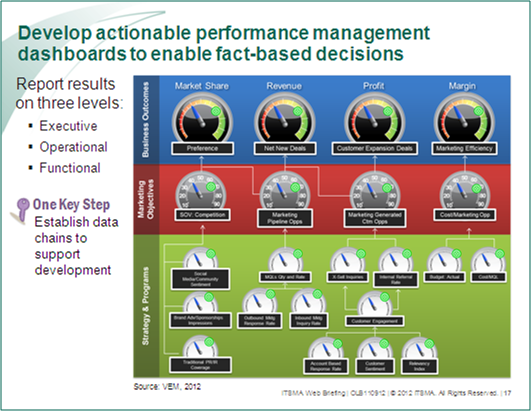The Five Metrics that Must be on Your Marketing Dashboard
by Laura Patterson, VEM and Julie Schwartz, ITSMA
Marketers are always asking us, “What are the five most important metrics that should be on our marketing dashboard?” These marketers want a template; a quick and easy answer so they can move on to their next challenge. Well, we’re not giving them the easy way out.
That’s because if you start building a dashboard for your leadership team with the individual metrics, you’re starting at the wrong place and you’ll end up with something that is useless.
Instead, you need to start to build your dashboard by answering these three simple (ok not that simple) questions:
- What are the outcomes that the business needs to achieve in order to meet their goals?
- What does senior management expect marketing to contribute towards these outcomes?
- How will senior management know that marketing has made a contribution?
Only when you have the answers to these questions can you begin to build a dashboard that shows how marketing generates value for the organization, the impact marketing has on the business, and what actions or course adjustments are required.
So the starting point for your dashboard is not metrics. Rather, you begin by having a conversation with senior management. You have to start from the top and work down. You also have to understand, your business and the role marketing plays. You can’t even begin to think about metrics until you’ve done this work.
More than One View of the Dashboard
Once you figure out what senior management wants to see, don’t slap yourself on the back and walk away. There’s more work to be done. The dashboard needs to be more than a reporting tool; it has to a multi-tiered, decision making tool that contains not just metrics for senior management, but also the data that the marketing managers need to run the marketing function and the marketers need to manage their programs.
Often this means that there needs to be at least three levels to dashboard:
- One that is used with the executive leadership team that communicates marketing’s value, impact and contribution,
- One that can be used by the marketing leadership to run the marketing organization, and
- One that can be used by functional members of the marketing team.

Each of these views needs to facilitate action and help marketing keep themselves on track (or in line with the business). Each level contains a set of metrics that is derived from aligning the marketing activities with business goals.
As a result of the business goal alignment, the metrics on each of the three levels don’t stand alone; they are linked to create data chains that show explicitly how the marketing program metrics contribute to the marketing function targets, which in turn drive the business outcomes. And the relationship among the metrics is not accidental—it’s all carefully planned.
Dashboards that contain data chains show the relationship between what the business is trying to accomplish and what marketing is doing.
The Test of a Good Dashboard
How do you know if you have a good dashboard? A good dashboard will answer the question, “Is what we are doing in marketing working? Are we moving the needles?” If the needles aren’t moving, a good dashboard will help you figure out why. Remember, a well-designed dashboard is a decision making tool, not a report.
For example, if the needles at the top—the business outcomes—are moving, and marketing is hitting its targets, then we can conclude that marketing is making a contribution. If the needles on the top aren’t moving, by looking down the data chains, we should be able to see why. Which marketing programs are not producing the marketing outcomes that contribute to those business outcomes? If those programs aren’t working, perhaps we need to stop what we are doing and reallocate the budget to something else?
In another scenario, we may see that marketing is exceeding its objectives in one area, but falling short in another. Again, we can use this information to reallocate the budget to ensure that marketing is contributing to each of the business outcomes identified by the senior leadership team.
Now you know why we can’t tell you which five metrics should be on your dashboard. Marketing dashboards are not one-size-fits-all. There is no one recipe for success. Only your senior management can tell you which metrics to include. It all starts with a conversation and hard work to understand your business and the role marketing is expected to play. This will reveal how to measure marketing’s value.
So start the conversation—and tell us how it goes!
